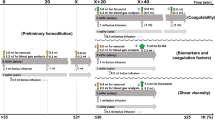Summary
In 21 patients with ischaemic strokes we have monitored plasma viscosity, total plasma concentration, numeric average molecular weight (Mn), and weight average molecular weight (Mw) of Dextran 40 (dextran) and hydroxyethylstarch 200/0.5 (HES) during 10 days of treatment (days 1–4, 2×500 ml; days 5–10, 1×500 ml). Plasma concentrations of dextran increased during the first 4 days (8.3 mg·ml−1 on the first day to 18.0 mg·ml−1 on the fifth day), reached an apparent steady state of 17.2 mg·ml−1 during the next 6 days, and declined subsequently with a half-time (t1/2) of 4.03 days. After ten days treatment Mn and Mw were shifted towards higher values. Plasma viscosity increased from 1.26 mPas to 1.69 mPas on Day 10 (p<0.01) and was linearly correlated with the total plasma concentration of dextran (p<0.001; r=0.88). Total plasma concentrations of HES averaged 11.7 mg·ml−1 on Day 1 and 12.4 mg·ml−1 on Day 5. The molecular weight distribution did not change during the infusions but decreased in comparison with the administered solution. Plasma viscosity fell from 1.40 mPas to 1.30 mPas at Day 10 (p<0.05) and was not related to the concentration of HES. The haemodiluting effect, as indicated by a decrease of the haematocrit, was 22% and 16.8% for dextran and HES respectively. These data suggest several advantages of HES compared with dextran in haemodilution therapy of ischaemic stroke.
Similar content being viewed by others
References
Thomas DJ (1985) Hemodilution in acute stroke. Stroke 16: 763–764
Kortilla K, Groehn P, Gordin A, Sundberg S, Salo H, Nissinen E, Mattila MAK (1984) Effect of hydroxyethyl starch and dextran on plasma volume and blood hemostasis and coagulation. J Clin Pharmacol 24: 273–282
Jan KJ, Usami S, Chien S (1982) The disaggregation effect of dextran-40 on red cell aggregation and deformability. Biorheology 19: 543–554
Hint H (1971) Relationship between the chemical and physicochemical properties of dextran and its pharmacological effects. In: Derrick JR, Guest MM (eds) Dextrans. Current concepts of basic action and clinical applications. Thomas CC, Springfield, pp 3–26
Arturson G, Granath K, Thoren L, Wallenius G (1964) The renal excretion of low molecular weight dextran. Acta Chir Scand 127: 543–5516
Arturson G, Wallenius G (1964) The intravascular persistence of dextran of different molecular sizes in normal humans. Scand J Clin Lab Invest 1: 76–80
Gray I (1953) Metabolism of plasma expanders studied with carbon-17-labelled dextran. Amer J Physiol 174: 462–466
Strauss RG (1981) Review of the effects of hydroxyethyl starch on the blood coagulation system. Transfusion 21: 299–302
Hulse JD, Yacobi A (1983) Hetastarch: An overview of the colloid and its metabolism. Drug Intell Clin Pharm 17: 334–341
Grotta JC, Pettigrew LC, Allen S, Tonnesen A, Yatsu FM, Gray I, Spydell J (1985) Baseline hemodynamic state and response to hemodilution in patients with acute cerebral ischemia. Stroke 16: 790–794
Haass A, Decker I, Jaeger H, Kiesewetter H (1985) Haemorheologische Optimierung der Infusionsbehandlung des zerebralen Insultes. In: Kiesewetter H, Ehrly AM, Jung F (eds) Haemorheologische Meßmethoden. Münchener Wissenschaftliche Publikationen, Homburg/Saar, pp 223–234
Scott TA, Melvin E (1953) Determination of dextran with anthrone. Anal Chem 25: 1656–1661
Foerster H, Wicarkzyk C, Dudziak R (1981) Bestimmung der Plasmaelimination von Hydroxyethylstärke mittels verbesserter analytischer Methodik. Infusionstherapie 2: 88–92
Granath KA, Kvist BE (1967) Molecular weight distribution analysis by gel chromatography on Sephadex. J Chromatogr 28: 69–81
Cullen MP, Turner C, Haycock GB (1985) Gel permeation chromatography with interferometric refractometry for the rapid assay of polydisperse dextrans in biological fluids. J Chromatogr 337: 29–36
Fahreus R, Lindqvist T (1931) The viscosity of blood in narrow capillary tubes. Am J Physiol 96: 562–568
Ferber HP, Nitsch E, Foerster H (1985) Studies on hydroxyethyl starch. Part 2: Changes of molecular weight distribution for hydroxyethyl starch types 450/0.7, 450/0.3, 300/0.4, 200/0.7, 200/0.5, 200/0.3, 200/0.1 after infusion in serum and urine of volunteers. Arzenimittelforsch/Drug Res 35: 615–622
Appel W, Wirmer V, Sprengard D (1968) Quantitative Mikrobestimmung von Dextran 1. Bestimmung in Körperflüssigkeiten. Z Klin Chem Klin Biochem 6: 452–458
Holford NHG, Sheiner LB (1981) Understanding the dose effect relationship. Clinical application of pharmacokinetic pharmacodynamic models. Clin Pharmacokinet 6: 429–453
Chmiel H, Anadere I, Walitza E, Witte S (1983) A combined apparatus for simultaneous determination of hematocrit and viscosity of blood. Biorheology 20: 408
Hint H (1967) Pharmacology of dextran. In: Pharmacia (ed) Dextran Symposium Amsterdam, pp 3–12
Koehler H, Zschiedrich H, Linfante A, Appel F, Pitz H, Clasen R (1982) Die Elimination von Hydroxyethylstärke 200/0.5, Dextran-40 und Oxypolygelatine. Klin Wochenschr 60: 293–301
Thoren L (1981) The dextrans — clinical data. Dev Biol Stand 48: 157–167
Kroemer H, Haass A, Jaeger H, Klotz U (1986) Dextran-40 and hydroxyethylstarch 200/0.5:Pharmacokinetic differences and their consequences for erythrocyte aggregation and plasma viscosity. Naunyn Schmiedebergs Arch Pharmacol 332: 384
Schmitt M, Cremer W (1983) Dextran-40 induziertes akutes Nierenversagen. Nieren-und Hochdruckkrankh 12: 301–305
Schwarz I, Ihle B, Dowling J (1984) Acute renal failure induced by low molecular weight dextrans. Austr Nz J Med 14: 688–689
Author information
Authors and Affiliations
Rights and permissions
About this article
Cite this article
Kroemer, H., Haass, A., Müller, K. et al. Haemodilution therapy in ischaemic stroke: Plasma concentrations and plasma viscosity during long-term infusion of dextran 40 or hydroxyethyl starch 200/0.5. Eur J Clin Pharmacol 31, 705–710 (1987). https://doi.org/10.1007/BF00541299
Received:
Accepted:
Issue Date:
DOI: https://doi.org/10.1007/BF00541299




